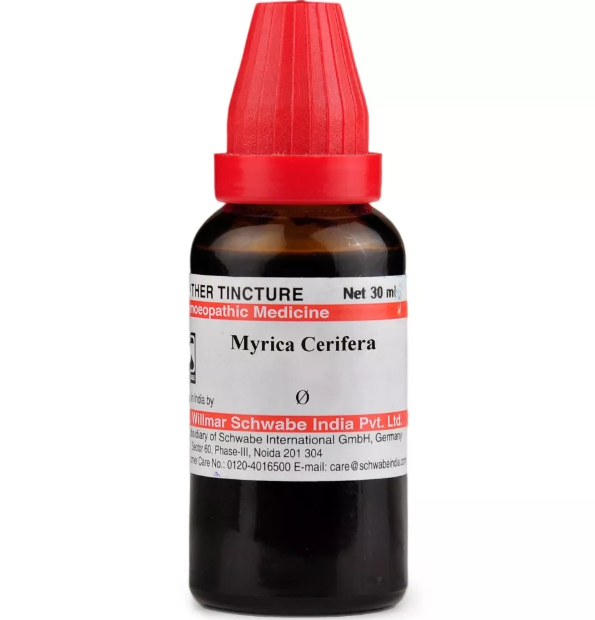MYRICA CERIFERA Q, 6C, 12C, 30C, 200C, 1M, 10M USES AND SYMPTOMS
 MYRICA CERIFERA
MYRICA CERIFERA
(Bayberry)
Myric.
Marked action on the liver and mucous membranes. Persistent sleeplessness. Jaundice.
Mind: Despondent, irritable, indifferent, gloomy.
Head: Tight scalp, headache with drowsiness, yellow sclera, aching eyeballs, pressure in the vertex and forehead, dull aching in temples and forehead on waking, pain and stiffness in the nape of the neck (cervical spondylosis).
Face: Yellow with itching, stinging, and creeping sensations.
Mouth: Furred tongue, bad taste, nausea, thick and tenacious secretion, tender and bleeding gums (scorbutic) (Merc.).
Throat: Constricted, rough feeling, constant desire to swallow, stringy mucus difficult to detach.
Stomach: Bitter and nauseous taste, halitosis, loss of appetite, fullness after eating, desire for acids, weak and sinking feeling in the epigastrium, relieved by rapid walking.
Abdomen: Dull liver pain, jaundice with bronze-yellow skin, loss of appetite, fullness in stomach and abdomen, scanty yellow frothy urine.
Rectum: Constant flatus when walking, urging to stool with only flatus expulsion, loose light-colored stool lacking bile.
Urinary: Dark, frothy, scanty, high-colored, biliary.
Extremities: Staggering gait, pain under shoulder blades, back of neck, all muscles, and hollow of right foot.
Sleep: Disturbed with bad dreams and frequent waking, insomnia.
Skin: Yellow and itchy, jaundice, creeping sensation as if from insects.
Relationship: Compare with Ptel., Corn., Chel., Lept., Fago. Antidote: Dig. (jaundice).
Dose: Tincture to third potency.
SYMPTOMS OF MYRICA CERIFERA
Mind:
Despondent
Irritable
Indifferent
Gloomy
Head:
Tight scalp
Headache with drowsiness
Yellow sclera
Aching eyeballs
Pressure in the vertex and forehead
Dull aching in temples and forehead upon waking
Pain and stiffness in the nape of the neck (cervical spondylosis)
Face:
Yellow complexion
Itching and stinging
Creeping sensations
Mouth:
Furred tongue
Bad taste in mouth
Nausea
Thick, tenacious secretion
Tender, bleeding gums (scorbutic)
Throat:
Constricted, rough feeling
Constant desire to swallow
Stringy mucus that is difficult to detach
Stomach:
Bitter and nauseous taste
Halitosis
Loss of appetite
Fullness after eating
Desire for acids
Weak and sinking feeling in epigastrium, relieved by rapid walking
Abdomen:
Dull pain in the liver region
Jaundice with bronze-yellow skin
Loss of appetite
Fullness in stomach and abdomen
Scanty, yellow, frothy urine
Rectum:
Constant flatus when walking
Urging to stool with only flatus expulsion
Loose, light-colored stool lacking bile
Urinary:
Dark, frothy, scanty, high-colored, biliary urine
Extremities:
Staggering gait
Pain under shoulder blades and back of neck
Pain in all muscles
Pain in the hollow of the right foot
Sleep:
Disturbed with bad dreams
Frequent waking
Insomnia
Skin:
Yellow and itchy
Jaundice
Creeping sensation as if from insects
selection of the potency
Individualization:
- Homeopathy is based on the principle of treating the individual, not just the disease. The unique symptoms and characteristics of the person are crucial in determining the most suitable potency.
Intensity of Symptoms:
- The intensity of the symptoms guides the choice of potency. If the symptoms are intense and acute, a lower potency (e.g., 6C, 30C) might be considered. For chronic conditions with less intensity, higher potencies (e.g., 200C, 1M) may be appropriate.
Sensitivity of the Patient:
- Some individuals are more sensitive to homeopathic remedies, while others may require higher potencies. The practitioner considers the patient’s sensitivity when selecting the potency.
Acute vs. Chronic Conditions:
- Lower potencies are often used for acute conditions, while higher potencies may be considered for chronic or long-standing issues.
Previous Response to Potencies:
- The patient’s response to previous homeopathic treatments helps guide the choice of potency. If a particular potency has been effective in the past, it may be repeated or adjusted as needed.
Vital Force and Susceptibility:
- Homeopathy views illness as a disturbance in the vital force. The practitioner assesses the patient’s overall vitality and susceptibility to determine the appropriate potency.
Aggravation or Amelioration:
- The direction of the symptom response (aggravation or amelioration) after taking a remedy can influence the choice of potency.
Miasmatic Considerations:
- In classical homeopathy, the concept of miasms (inherited disease tendencies) is considered. The practitioner take this into account when selecting the potency.
Practitioner Experience:
- The experience and preference of the homeopathic practitioner play a role. Some practitioners may have success with certain potencies based on their clinical experience.
SAFETY INFORMATION
- Do not exceed the recommended dose by physician
- Keep out of the reach of children
- Store in a cool dry place away from direct sunlight
- Maintain half an hour gap between food/drink/any other medicines and homoeopathic medicine
- Avoid any strong smell in the mouth while taking medicine e.g. camphor, garlic, onion, coffee, hing
Medicine images use for reference only selection of homeopathic medicine depends on the individual’s specific symptoms and overall constitution. Moreover, homeopathy is a holistic system of medicine that treats the individual as a whole. In addition to addressing the physical symptoms, it takes into account the emotional and mental state of the person. Consequently, it’s crucial to consult with a qualified homeopathic practitioner for personalized treatment.
The information provided on this website is intended solely for educational purposes. Always seek the advice of your physician or other qualified health provider.
